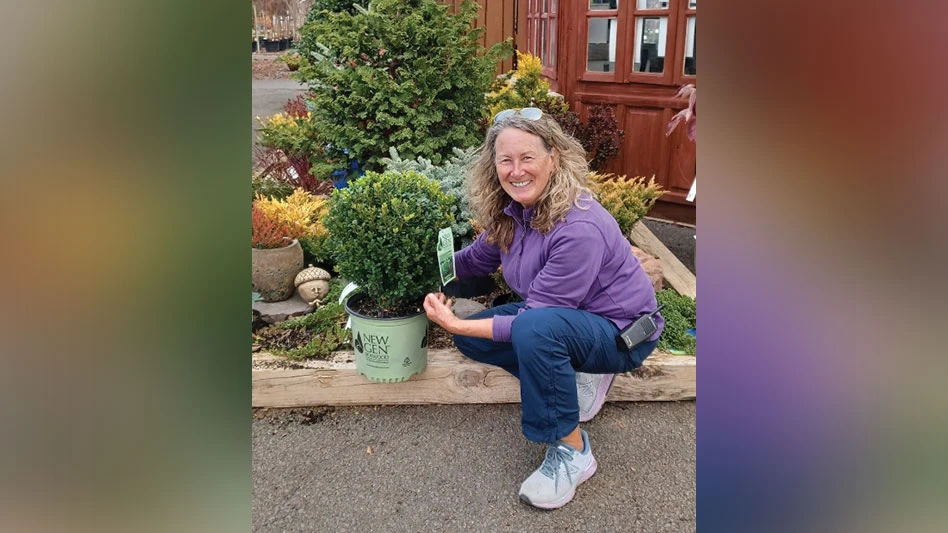

Michigan’s Spring Meadow Nursery is known for being a leader in wholesale plant production, producing millions of liner shrubs yearly, primarily for the Proven Winners ColorChoice brand.
When you head to Spring Meadow’s website, you’ll find over half of their full-time employees are women. Similarly, in their growing department, five of the eight staff members are women.
Increasingly, women are moving into male-dominated industry roles, changing how our nurseries look and perform. We asked these five growers what attracted them to plant production, what challenges they face, and how women are an asset to nurseries.
Denise Sikkema has been with Spring Meadow for nearly 22 years. She wears many hats, but her primary role is managing space and product flow. Each week she scouts propagules, deciding which crops are rooted enough to transfer out of the propagation houses and into the growing ranges. She organizes product based on size, pest pressures, and cultural requirements and consolidates bays to make space for new product. She also manages the inventory and sets up new introductions as a super-user in their inventory management system.
When asked if she has seen any gender changes in her department over the years, Sikkema recalled that the department has always been pretty balanced. “Hiring is something Spring Meadow does well,” Sikkema says. “Dale [Deppe, Spring Meadow owner] doesn’t think about whether someone is male or female. His concern is can they do the job, and how well.”
Attracting these skilled applicants shows in the nursery’s newest hires.
Kristin Spicer started at Spring Meadow in late-2021 but has worked in the industry for three years. Her interest in horticulture started in the family garden with her mother. Nurturing plants is something she brings to the five acres of shrubs under her care.
Does the fact that she’s a woman give her a leg up when it comes to quality? It could be argued yes, it does. In general, women are taught that caring for living things and bringing them to a healthy, well-developed state is something in which they can excel.
Women bring energy and innovation to horticulture. Freedom Shelley, who started at Spring Meadow about two years ago, sees the industry as the perfect place for women to innovate and implement new ideas. “For example,” she says, “…our female growers implemented a whole biological control program!”
Jessica Gulczynski, seven years at Spring Meadow, further described the program. “Our team has been able to breed certain biologicals in-house using banker carts and containers. Native plants provide food and habitat for our beneficial insects and the banker containers attract outside beneficial predators native to Michigan into our greenhouses, adding another crucial element to our successful biological control program.”
Gulczynski enjoys working with a team of women who are focused on working cohesively with nature and their surroundings, implementing non-traditional industry standards to solve problems.
But that doesn’t mean there still aren’t hurdles to overcome. The age-old struggle to be seen as equals still exists. Women’s opinions might be weighed differently. To that, Spicer says, “In my experience, sometimes new ideas are taken less seriously when you’re a woman.” That’s why being on a team with other women is so important.
Sikkema also feels that women have some ground to make up in sciences and manufacturing. “I think the biggest challenge is for our communication style to be heard with the weight and credibility it deserves to gain more leadership seats.”
Grace Fricano, assistant growing manager for seven years, feels there is some stereotyping to address. She says, “Although we are seeing more and more women in the field, it is still pretty male-dominated.”
Across the industry, she doesn’t see as many female role models as she’d like but at Spring Meadow, she says, “…we have had some amazing women role models and I feel lucky that I get to work beside them.”
Shelley sees herself as a role model, and her inclusion in the workforce allows her to be the next example for young women, showing them they have a place in agriculture.
Could this cognizance of how they are perceived by women who are considering entering the industry, make them the next great leader?
Fricano thinks so. She thinks women make great managers. “We are flexible, excel at multitasking, and can come together as a team without egos and get the job done.” At the end of the day, Fricano says women look out for each other, “…and I think that brings us together.”
An instinct to lead by example adds perspective to the field. That kind of teamwork makes a positive impact on the bottom line. Spicer sees this clearly, “Since women are the bulk of our customer base, our input during production is highly valuable.”
Finally, we asked Sikkema what she would recommend nurseries do to retain workers, especially women? “My answer isn’t specific to Spring Meadow, but the industry as a whole,” she says. “Younger generations, millennials and Gen-Z, are forcing the business landscape to address work-life balance. If we want to recruit and retain quality people, we have to lean into modern organizational structures.”
The nursery industry is experiencing unprecedented growth. These five make it clear that to be able to keep the pace of expansion and innovation, the future is – must be, in fact – female.

Explore the September 2022 Issue
Check out more from this issue and find your next story to read.
Latest from Nursery Management
- The Growth Industry Episode 3: Across the Pond with Neville Stein
- What's in a name?
- How impending tariffs and USDA layoffs impact the horticulture industry
- Shifting the urban environment
- These companies are utilizing plastic alternatives to reduce horticultural waste
- How to create a sustainable plant nursery
- Lamiastrum galeobdolon ‘Herman’s Pride’
- One of rarest plants on earth: Tahina spectabilis





